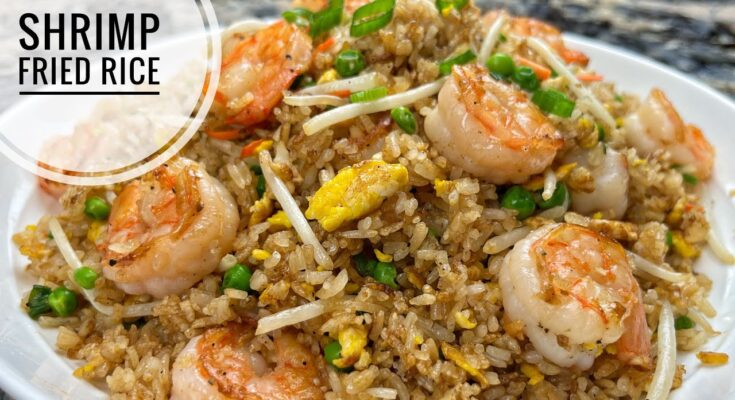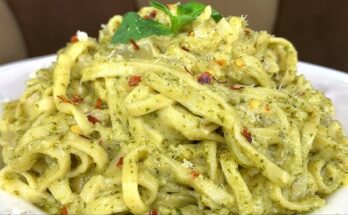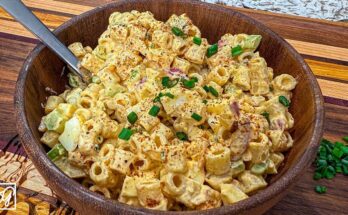Shrimp and Rice Recipe: There’s something incredibly comforting about the aroma of a shrimp and rice dish wafting through your kitchen. It’s a recipe that knows no borders—cherished across continents, from the spicy Creole kitchens of Louisiana to the vibrant coastal regions of Southeast Asia. What makes shrimp and rice so appealing is its simplicity paired with the potential for bold, dynamic flavors.
This dish is more than just a meal—it’s an experience. Whether you’re a seasoned cook or a kitchen novice, this guide will walk you through each step with ease. We’re talking about juicy, marinated shrimp nestled into tender, flavorful rice infused with spices and sautéed veggies. It’s a hearty, one-pan wonder that works just as well for busy weeknights as it does for impressing guests at dinner.
Plus, it’s customizable to your preferences—want it spicier? No problem. Prefer brown rice? Go for it. Shrimp and rice is as flexible as your cravings, and once you learn the basics, you’ll be ready to make it your own.
Ingredients You’ll Need
Before you dive into cooking, gather your ingredients. This dish shines with freshness, so try to use the best quality you can find.
For the shrimp:
- 1 lb large shrimp, peeled and deveined
- 1 tbsp olive oil
- Juice of half a lemon
- 2 cloves garlic, minced
- 1 tsp paprika
- Salt and pepper to taste
For the rice base:
- 1 cup long-grain rice (jasmine or basmati work beautifully)
- 2 cups chicken broth (or vegetable broth)
- 1 small onion, finely chopped
- 1 bell pepper (red or yellow), diced
- 1 tomato, chopped
- 2 tbsp olive oil
- 1/2 tsp cumin
- 1/2 tsp smoked paprika
- 1/4 tsp cayenne pepper (optional for heat)
- Salt to taste
- Fresh parsley for garnish
Using fresh shrimp is ideal, but frozen works in a pinch. Just make sure to thaw them properly beforehand. As for the rice, long-grain types tend to stay fluffy and separate, avoiding that mushy texture.
Kitchen Tools Required
You don’t need a fancy setup to pull off a great shrimp and rice dish. Here’s a simple checklist of kitchen tools to get the job done smoothly:
- Large skillet or sauté pan with a lid
- Sharp knife for chopping vegetables
- Cutting board
- Mixing bowls
- Measuring cups and spoons
- Wooden spoon or spatula
Optional tools like a garlic press or citrus juicer can save time and effort, especially if you cook often. A cast iron skillet can also elevate the flavors with its superior heat retention and ability to caramelize ingredients.
Preparing the Ingredients
Getting everything ready beforehand—known as mise en place in the culinary world—makes the cooking process faster and smoother.
Shrimp Prep: Start with thawing the shrimp if they’re frozen. Rinse them under cold water and pat dry with a paper towel. Remove the shell if not already peeled and make sure they’re deveined. That dark line running down the back isn’t dangerous, but it’s not pleasant either. You can use a small paring knife or a shrimp deveiner.
Rice Prep: Rinse the rice under cold water until the water runs clear. This removes excess starch and helps the grains stay fluffy. Some like to soak the rice for 10-15 minutes before cooking—it’s optional but does help the texture.
Veggie Prep: Chop the onion, dice the bell pepper, mince the garlic, and prepare the tomato. Keep these ready in small bowls so you can add them quickly when needed.
Cooking the Perfect Shrimp and Rice
Now comes the exciting part—putting everything together in a delicious, steamy, flavor-packed dish.
Step 1: Marinate the Shrimp
Place your cleaned shrimp in a bowl. Add olive oil, lemon juice, minced garlic, paprika, salt, and pepper. Mix well so the shrimp are evenly coated. Let them marinate for at least 15 minutes. This simple marinade not only adds flavor but also tenderizes the shrimp.
Want to elevate it further? Add a splash of white wine or a pinch of chili flakes. Just don’t over-marinate, especially with acid like lemon juice—shrimp can become rubbery if left too long.
Step 2: Cook the Vegetables
Once your shrimp are marinating, it’s time to build the base flavors of your dish with vegetables. Heat 2 tablespoons of olive oil in a large skillet over medium heat. When the oil is hot but not smoking, toss in your chopped onions. Let them cook for about 3 to 5 minutes until they turn soft and translucent.
Next, add the minced garlic and diced bell pepper. Stir everything together and let them sauté for another 4 to 5 minutes. The goal here is to bring out the natural sweetness of the vegetables while creating a fragrant base that’ll seep into every grain of rice. At this stage, add the chopped tomato and stir everything well.
You can also toss in a pinch of salt to help break down the veggies quicker. If you want to go bolder, add a splash of white wine or a tablespoon of tomato paste—it intensifies the depth of the final flavor.
Step 3: Add Spices and Broth
Now, it’s time to bring in the magic—spices! Add cumin, smoked paprika, cayenne pepper (if you’re using it), and a little more salt to the pan. Stir well to coat all the vegetables with this aromatic blend.
Pour in your chicken or vegetable broth. Give everything a good stir, scraping up any browned bits at the bottom of the pan—that’s where so much flavor lives. Once the broth is simmering, it’s time to introduce the rice. Gently add the rinsed rice to the skillet and stir once more so everything is evenly distributed.
Bring the mixture to a boil, then reduce the heat to low. Cover the pan with a tight-fitting lid and let it simmer for about 18–20 minutes. Don’t be tempted to lift the lid—steam is crucial to getting that perfectly fluffy texture.
Step 4: Simmer the Rice
This is a crucial part of the process. Simmering allows the rice to slowly absorb all the flavors from the broth, veggies, and spices. Keep the heat low and the lid on for best results.
After 18 minutes, check the rice. If the liquid is fully absorbed and the grains are tender, it’s ready. If not, give it another few minutes. Don’t worry if the bottom gets a little crispy—that golden crust is called “socarrat” in Spanish cuisine and is considered a delicious bonus!
If you’re worried about sticking, give the pan a gentle shake rather than stirring. Stirring can sometimes break the rice or make it sticky.
Step 5: Add the Shrimp
Once the rice is nearly done, nestle the marinated shrimp into the skillet, placing them evenly across the top. Cover again and cook for another 5–6 minutes. The steam from the rice will gently cook the shrimp, keeping them tender and juicy.
Shrimp cook fast—you’ll know they’re done when they turn pink and opaque. Don’t overcook them; rubbery shrimp can ruin the whole dish. For a little extra flavor, squeeze a bit more lemon juice over the top just before serving.
Once done, remove the skillet from heat and let it sit for 5 minutes with the lid on. This resting period helps all the flavors meld together beautifully.
Tips for the Perfect Dish
Every great recipe has its secrets, and shrimp and rice is no different. Here are some pro tips that will elevate your dish from good to absolutely mouthwatering:
1. Use fresh, quality ingredients: Fresh shrimp make a big difference in flavor and texture. If using frozen, ensure they’re completely thawed and patted dry before cooking. Use fragrant, high-quality spices and fresh veggies for the best taste.
2. Don’t overcook the shrimp: Shrimp only need a few minutes to cook. Once they turn pink and opaque, they’re done. Leaving them on heat for too long will make them chewy and tough.
3. Keep the rice fluffy: Resist the urge to stir the rice while it cooks. Stirring releases starch and makes it gummy. Letting it cook undisturbed with the lid on ensures each grain stays separate and fluffy.
4. Balance your spices: Taste as you go. If it feels too bland, a dash of lemon juice or a sprinkle of salt can do wonders. Too spicy? Stir in a spoonful of yogurt or sour cream to mellow things out.
5. Let it rest before serving: Once everything is cooked, allow the dish to sit covered for about 5 minutes. This final step helps all the flavors come together and makes serving easier.
These tips might seem small, but they make a world of difference. Follow them and your shrimp and rice will turn out perfect every time.
Variations of Shrimp and Rice
The beauty of this dish lies in its versatility. You can tweak the recipe depending on your mood or what you have in your pantry.
1. Cajun Shrimp and Rice: Add Cajun seasoning, sausage, and a bit of hot sauce. This version is smoky, spicy, and deeply satisfying.
2. Spanish-style Shrimp and Rice (Paella-inspired): Add saffron, peas, and roasted red peppers. You can even throw in some chorizo or mussels for extra richness.
3. Asian Shrimp Fried Rice: Use day-old cooked rice, add soy sauce, sesame oil, green onions, and scrambled eggs for a quick stir-fry style meal.
4. Coconut Shrimp and Rice: Cook the rice with coconut milk and add a bit of lime zest for a tropical twist. A handful of chopped cilantro takes it over the top.
5. Tomato Basil Shrimp and Rice: Add fresh chopped tomatoes and basil with a splash of white wine. It’s light, fragrant, and perfect for summer dinners.
Each variation brings something new to the table, so don’t be afraid to experiment. Mix and match spices, herbs, and add-ins to find your personal favorite.
Serving Suggestions
Presentation matters—especially when you’re proud of what you’ve cooked! Here’s how to serve shrimp and rice to make it look as good as it tastes:
- Garnish with fresh herbs: A sprinkle of chopped parsley or cilantro adds color and freshness.
- Serve with lemon wedges: The acidity enhances the shrimp’s flavor.
- Add a dollop of aioli or flavored yogurt: Great for cutting through spice and adding a creamy element.
- Pair with a side salad: Something light like a cucumber-tomato salad or coleslaw balances the richness.
- Serve it in a bowl: It keeps the heat in and makes it easy to scoop up every bite.
Don’t forget a cold drink to wash it down—iced tea, a crisp white wine, or even a citrusy soda all pair well.
Storing and Reheating
Made too much? No worries—shrimp and rice stores quite well if done right.
Storing:
- Allow the dish to cool to room temperature before storing.
- Transfer to an airtight container and refrigerate for up to 3 days.
- You can also freeze it for up to 2 months. Portion it into single servings for easy lunches.
Reheating:
- Microwave: Add a splash of water or broth to keep it moist. Cover with a damp paper towel and heat for 1–2 minutes.
- Stovetop: Reheat in a pan over low heat with a bit of oil or broth. Stir gently until warmed through.
- Oven: For larger portions, use a covered baking dish at 350°F (175°C) for 15–20 minutes.
Avoid overcooking the shrimp during reheating to maintain their texture. If possible, set aside a few shrimp before initial cooking and sauté them fresh when reheating for best results.
Health Benefits
This dish isn’t just tasty—it’s packed with nutrients, too.
Shrimp Benefits:
- Low in calories and high in protein
- Rich in selenium, vitamin B12, and omega-3 fatty acids
- Contains antioxidants like astaxanthin, good for skin and heart health
Rice Benefits:
- Provides energy through complex carbs
- Brown rice adds fiber, vitamins, and minerals
- Gluten-free, making it suitable for those with sensitivities
Vegetables and Spices:
- Add essential vitamins and antioxidants
- Garlic and onion can boost immune health
- Bell peppers are high in vitamin C
To make it even healthier, you can:
- Use brown rice instead of white
- Reduce oil and salt
- Load up on extra vegetables like spinach, zucchini, or carrots
This makes shrimp and rice a well-rounded meal that doesn’t just taste good—it’s good for you, too.
FAQs about Shrimp and Rice Recipe
1. Can I use frozen shrimp for this recipe?
Yes! Just be sure to thaw them completely and pat them dry before marinating. This helps the shrimp absorb the flavors and cook evenly.
2. What type of rice works best for shrimp and rice?
Long-grain varieties like jasmine or basmati are ideal because they cook up fluffy and don’t clump together. Brown rice works too but needs a longer cook time.
3. How do I keep shrimp from becoming rubbery?
Avoid overcooking. Shrimp only need 4–6 minutes to cook through. They should turn pink and opaque—once they do, pull them off the heat immediately.
4. Can I make this dish vegetarian or vegan?
Absolutely! Swap shrimp for tofu or mushrooms, and use vegetable broth. The same spices and techniques work beautifully for a plant-based version.
5. How long will shrimp and rice last in the fridge?
Stored in an airtight container, it’ll last up to 3 days in the refrigerator. For longer storage, freeze portions for up to 2 months.
Final Thoughts
The real charm lies in its flexibility. You can make it spicy or mild, exotic or classic, quick or slow-cooked. Whether you’re cooking for family dinner, meal prepping for the week, or hosting a casual get-together, shrimp and rice always hits the spot.
Plus, it’s budget-friendly, easy to store, and packed with nutrients. With a few pantry staples and fresh ingredients, you can whip up a dish that rivals your favorite restaurant’s offerings—right in your own kitchen.
So next time you’re wondering what to cook, let shrimp and rice be your answer. It’s satisfying, delicious, and always a crowd-pleaser.



